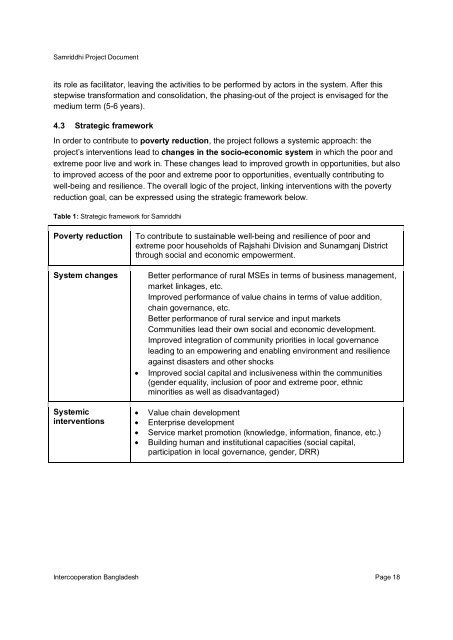Samriddhi
Samriddhi
Samriddhi
Create successful ePaper yourself
Turn your PDF publications into a flip-book with our unique Google optimized e-Paper software.
<strong>Samriddhi</strong> Project Document<br />
its role as facilitator, leaving the activities to be performed by actors in the system. After this<br />
stepwise transformation and consolidation, the phasing-out of the project is envisaged for the<br />
medium term (5-6 years).<br />
4.3 Strategic framework<br />
In order to contribute to poverty reduction, the project follows a systemic approach: the<br />
project’s interventions lead to changes in the socio-economic system in which the poor and<br />
extreme poor live and work in. These changes lead to improved growth in opportunities, but also<br />
to improved access of the poor and extreme poor to opportunities, eventually contributing to<br />
well-being and resilience. The overall logic of the project, linking interventions with the poverty<br />
reduction goal, can be expressed using the strategic framework below.<br />
Table 1: Strategic framework for <strong>Samriddhi</strong><br />
Poverty reduction<br />
System changes<br />
Systemic<br />
interventions<br />
To contribute to sustainable well-being and resilience of poor and<br />
extreme poor households of Rajshahi Division and Sunamganj District<br />
through social and economic empowerment.<br />
Better performance of rural MSEs in terms of business management,<br />
market linkages, etc.<br />
Improved performance of value chains in terms of value addition,<br />
chain governance, etc.<br />
Better performance of rural service and input markets<br />
Communities lead their own social and economic development.<br />
Improved integration of community priorities in local governance<br />
leading to an empowering and enabling environment and resilience<br />
against disasters and other shocks<br />
• Improved social capital and inclusiveness within the communities<br />
(gender equality, inclusion of poor and extreme poor, ethnic<br />
minorities as well as disadvantaged)<br />
• Value chain development<br />
• Enterprise development<br />
• Service market promotion (knowledge, information, finance, etc.)<br />
• Building human and institutional capacities (social capital,<br />
participation in local governance, gender, DRR)<br />
Intercooperation Bangladesh Page 18
















